Modified product properties, more efficient production processes, higher energy output or re-usable components are industry requirements that can often be solved by using new nanotechnology materials. The industrial sector in Germany‘s Saarland has long had a research infrastructure to draw on in developing such materials, focusing on both the development stage and their production process. This is a successful concept, as examples of industry implementation show.
The INM Leibniz Institute for New Materials in Saarland develops the materials of the future, working for and in conjunction with industry. The institute is able to cover a wide range of fields, from market-specific needs analyses to developing new products to pilot production. Its clients cover numerous sectors, from start-ups to regional SMEs to large international groups.
Climate neutrality, saving energy, preserving resources – there are many challenges facing producing companies in particular. To find out more about how the worlds of industry and research can work together to tackle this, we spoke to two researchers from the INM who have been working closely with industry for years – Dr. Peter William Oliveira, head of the INM’s InnovationCentre and the Optical Materials programme, and Dr. Martin Amlung, deputy head of Optical Materials.
gwSaar:
What is the role of the INM InnovationCentre?
Dr. Peter Oliveira:
The INM Leibniz Institute for New Materials undertakes fundamental and applied research in the field of nanotechnology. The InnovationCentre serves as a crucial bridge between industry and INM research. All innovation activities at the INM, strategic orientation, technology evaluation and patent management run through here.
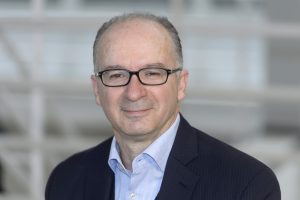
Dr. Peter William Oliveira, head of the INM InnovationCentre and the Optical Materials programme, works with his team to develop new materials with and for industry. Experience and a passion for research are key requirements for this. Photo: INM gGmbH – Leibniz-Institut für Neue Materialien
Dr. Martin Amlung:
We at the InnovationCentre support industrial projects, from implementation to developing pilot series and the subsequent downstream upscaling, including quality control. The technologies developed by INM are incorporated into this and form part of further planning as well as evaluation processes. Our in-house contract and patents department allows us to ensure quick, efficient collaborations across all levels.
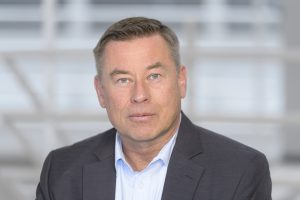
Martin Amlung, deputy head of Optical Materials, links up industry requirements with scientific expertise. Photo: INM gGmbH – Leibniz-Institut für Neue Materialien
Dr. Peter Oliveira:
In order to purposefully promote progress and keep our developments up to date, we conduct needs and market analyses. And sometimes, it becomes clear that interesting developments are ahead of their time.
Dr. Martin Amlung: It can then take a while until the time is ripe for the relevant development. One example of this is electrochromic windows, which we developed 15 years ago. A small change in voltage between 2 and -2 volts can be used to darken and lighten electrochromic glass. This system was only first put to use in rear-view mirrors for cars. It had not been of interest for the architecture we were originally focusing on. They were relatively costly to manufacture and the glass could not be cut to a custom size after production.
Today, the system is much more attractive, thanks to different climate conditions and a greater need to provide shade. We are therefore currently launching a publicly funded project with industrial partners to transfer the system over to film. This can then be custom cut and comes with much lower production costs.
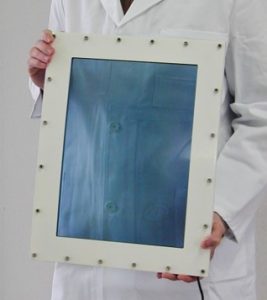
Electrochromic windows, an INM development, can be darkened and lightened via small changes in voltage
gwSaar:
The INM works directly with and for companies to develop new materials. How does this collaboration work?
Dr. Peter Oliveira:
If companies think they can use new nanotechnology materials to solve a problem, they generally search for potential development partners across the globe. The INM has 12 nanotechnology research focuses and has 70 active basic patents (or system solutions) in these areas. This makes it a potential partner for a variety of areas.
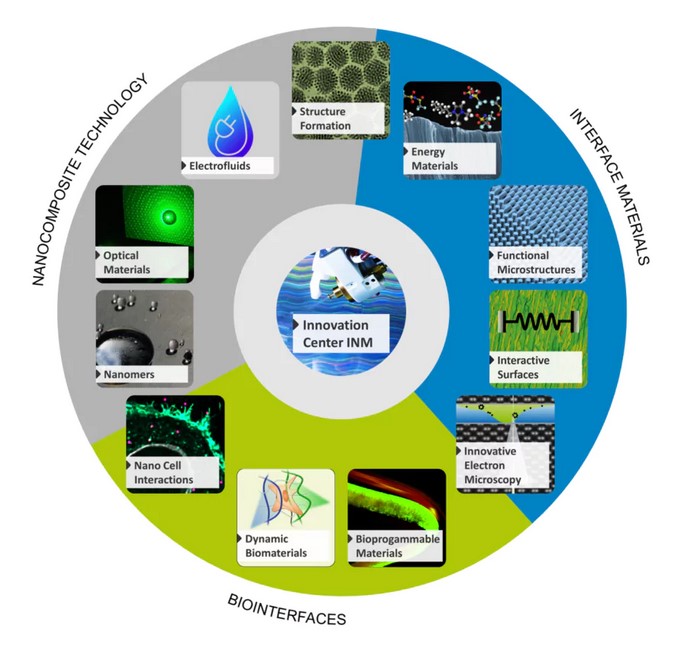
The INM in Saarland develops solutions for industry all over the world. It incorporates expertise from twelve research focuses.
We cover every step in the process, from a feasibility study through to materials development and the corresponding production process. When a collaboration begins, as well as understanding the precise requirements, we also need to understand the company’s previous processes. Trust-based cooperation and maximum openness are crucial for this. Once we have understood the problem and the requirements, we can begin.
gwSaar:
Can you tell us about a couple of products that have been developed at INM?
Dr. Peter Oliveira:
Many of our projects are confidential during the project phase and beyond, and cannot be announced.
Dr. Martin Amlung:
But there are a few things we have been involved in that everyone uses, and that we are also allowed to talk about. For example, one of the safety features of the 100 and 200 euro notes, a foil hologram, was developed by the INM in conjunction with the company sectago.
Dr. Peter Oliveira:
Or the transparent emergency call antenna; many cars now have a transparent antenna in their windscreen that automatically triggers an emergency call in the event of an accident. This antenna printed into the glass was developed by INM.
gwSaar:
What role does funding play in the INM’s industry-related research?
Dr. Martin Amlung:
In an industrial project, we generally use a public project to research a technology base. A company’s specific requirements are then developed in a subsequent industrial project that builds on this. If the problem can be solved using one of our basic patents, we can of course also develop specific adaptations.
gwSaar:
What are the biggest challenges for companies wanting to use new nanotechnology materials?
Dr. Peter Oliveira:
As well as development, the production process is primarily what demands a lot from a company. The raw materials used are not a major cost factor. We work on a nano level, so even expensive materials like silver or platinum are not really consequential. The production process is rather different – companies often have to invest in costly new machinery.
Dr. Martin Amlung:
We therefore always start from the production process when we begin our considerations. All industrial projects that go beyond just a pure feasibility study are developed in a process-oriented way. At the InnovationCentre, we build on the relevant pilot systems to enable companies to begin production on a certain scale.
gwSaar:
Can companies undertake production at the INM InnovationCentre?
Dr. Peter Oliveira:
Yes, it is possible to produce small series onsite and thus start by testing the market, say for a year or two. Next, the company can hire labour and facilities from us, acquire a facility, or for larger industrial-scale projects, even find a producer or build their own production facility. This therefore hugely reduces the commercial risk of investing in new technology.
gwSaar:
You presented a proximity sensor at the Hannover Messe. What makes this new sensor special?
Dr. Martin Amlung:
This sensor is a good example of process-oriented development. Installing transparent sensors on non-conductive surfaces is generally very expensive. We use electrospinning, known from areas such as carpet making, i.e. a low-tech process that is not only significantly cheaper but also enables the production of very large sensor areas. Our system even enables sensors to be produced on the roll and then subsequently cut to the desired size. This is because both glass and film can be used as the medium for the transparent conductive net. Electrospinning creates a chaotic network of conductive fibres that are a hundred times thinner than a human hair and invisible to the human eye.
gwSaar:
How important are international collaborations to the INM InnovationCentre?
Dr. Peter Oliveira:
Very important, we are constantly seeking international exchange and international projects. We also receive fantastic support from the political arena and economic promotion in Saarland.
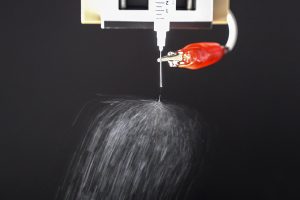
Electrospinning for the production of flexible, transparent proximity sensors – a low-tech process for producing a high-tech product.
Every industrial project teaches us something. We have a technology base that we are consolidating with every industrial project. If we work with companies abroad we adopt their (and thus a different) perspective, as every country – like every company – industrialises things in their own particular way.
Conductive fibres invisible to the naked eye, used in INM’s newly developed flexible proximity sensor.
(left: microscope1, right: microscope 2)
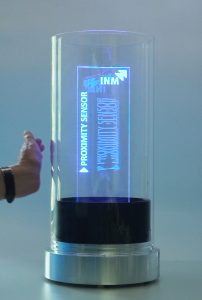
The entire film of the INM proximity sensor (shown here as a pillar) can be used to trigger actions when approached. It is also possible to program different actions, for example by using specific hand movements.
Let me offer an example. When we started working on touch sensors, there was no talk of manufacturing them in Europe, but now there is. We worked with Asian companies on this and learned a lot, for example how you build, characterise and design a touch sensor. We consolidated our technology base via partnerships. Today, an increasing number of touch sensors and proximity sensors are being integrated into virtually all product areas, and we can help both regional and international companies with development for their specific applications thanks to our technology base.
gwSaar:
What do you feel is your role as a researcher?
Dr. Peter Oliveira:
Enabling sustainability in all its forms is very important to us, from energy production, use and storage to developing recyclable materials to resource-efficient processes.
The path to such solutions always begins in the same way. In the laboratory, you have to start with a dream, forget physics and chemistry, and free your thinking. This is something we are able to do here – to speak and think without restrictions.
This ability to dream and not become deadened is what we do.
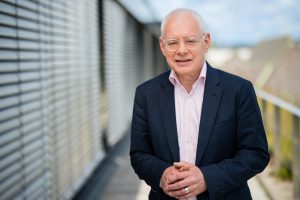
Jürgen Barke, Minister of Economics, Innovation, Digitalisation and Energy and Deputy Prime Minister, understands the huge role that the scientific world is playing in overcoming the challenges that face many companies today.
It takes support from all sides to transform research dreams into reality. This is something that research and industry in Saarland are able to rely on, because the political arena is aware of the importance of the research sector for industry, and therefore supports companies and institutes that are researching and expediently deploying products and processes for the industrial future.
Minister of Economics Jürgen Barke therefore emphasises: ‘We set the course for successful nanotechnology research in Saarland several years ago. The establishment and long-term funding of the INM Leibniz Institute for New Materials played a key role in this. Developing new materials is extremely important for an industrial location like ours, as research input gives rise to new products, which result in the creation of new companies for their production and distribution. Furthermore, joint research conducted by science and industry, and in particular international collaborations, are vital for achieving sustainability, climate neutrality and energy efficiency in products and production processes. As a Ministry, we help companies achieve their goals against the backdrop of such challenges.’
Making dreams a reality does not happen overnight, but rather often requires years of research work. More than a few of the resulting developments from Saarland institutes and Saarland University have been picked up by young entrepreneurs and brought to the market. There is therefore an interesting start-up scene in the field of nanotechnology developments and new materials. One of these start-ups that has turned a research dream into product reality is the Saarland company Innocise, which has developed a new bioinspired material that opens up new opportunities for robot and plant manufacturers.
Whether via electricity, vacuum or compressed air, whenever an industrial robot grips something, it consumes energy. The company Innocise, a spin-off company of the INM Leibniz Institute for New Materials in Saarland, is seeking to ensure that this energy can be conserved for the future. This is made possible by a unique adhesive technology modelled on the gecko. Based on fundamental research conducted by Prof. Eduard Arzt, director of INM and co-founder of INNOCISE, microstructured special polymers were developed that adhere reversibly to a wide variety of materials. We spoke to Dr. Marc Schöneich, CEO and co-founder of INNOCISE, about the progress being made in climate-neutral production.
gwSaar: Mr Schöneich, producing companies are being required to demonstrate climate neutrality and energy efficiency. INNOCISE offers a new technology that can specifically help in this area – gripping without energy input. That sounds too good to be true. How does it work?
Dr. Marc Schöneich: Production, i.e. the creation and manufacture of goods and commodities, always involves modern plant engineering. This may for example be highly automated steel production, or chip or sensor production with innovative robotics.
All of these processes contain procedures in which objects must be fixed, gripped or moved. The engineering behind it is often energy-intensive and highly complex. Compressed air, which is now widely used, is one of the most expensive production media of all. This is where INNOCISE comes in.
Building on our Gecomer® technology, we produce special polymers that are able to handle components ranging from several metres to fewer than 10 micrometres in size, all with maximum precision and efficiency. Inspired by what is known as the ‘gecko effect’, the gripping and release mechanism operates without external energy input or residue – via Van der Waals interactions.
Our efficient new way of handling sensitive components not only taps huge savings potential (as previously mentioned), but also increases production throughput.
gwSaar: The aim of Industry 4.0 is to digitalise and network all processes. Will this need to be expanded in the future with an energy efficiency element, Industry 4.0.E so to speak? And how can your Gecomer® technology enable greater energy efficiency in the production process?
Dr. Marc Schöneich: In view of the current climate situation, demand for carbon-neutral production and energy efficiency is becoming a must rather than a nice-to-have. This is also true for preserving Europe, Germany and Saarland as a production location.
Assume that energy efficiency will become an evident requirement for companies in the future. ESG (environmental, social and governance) factors will become increasingly important and play a key role in a company’s success. In this context, we view our product as a building block for creating climate-neutral industry.
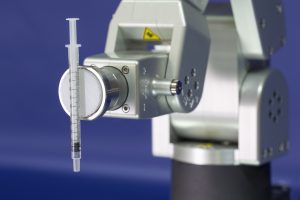
The new grippers can grip in situations where suction technology no longer works, e.g. with very small parts. However, it also performs precise work on a macro level.
‘Green’ and energy-free gripping systems are our mission. With our bioinspired handling solutions, we replace costly and resource-intensive (suction) grippers and offer clients a wide range of applications for the automation of the future – without cables, electronics, compressed air or the associated peripherals: from picking and placing tiny microLEDs to fuel cell production and clean room applications to side-window installation in trains.
gwSaar: You and Prof. Eduard Arzt decided to establish your start-up in Saarland. What impressed you about this location?
Dr. Marc Schöneich: We looked at numerous locations, both at home and abroad, before founding the company. As a start-up providing a new, fully developed technology, you have access to a really very attractive package of services. Our decision was not based on the financial support available, which would have been better in other locations. There were two key factors in our decision: Where could we find good networks? And where could we find the staff that we needed? Saarland scores well on both counts.
Saarland advertises itself as offering short transport routes, which I can only confirm. Here we have access to open networks and helpful people. Whether research, KWT (the Office for Knowledge and Technology Transfer of Saarland University – author’s note), industry or politics, contact with decision-makers is always rapid. All of the key players in Saarland are very interested in the challenges facing new companies, and there is also a willingness to help these young companies overcome said challenges.
We are already working with other companies on creating a future structure to codify this willingness to cooperate. Working with the association DeepTechSaar, we want to further improve open exchange and mutual support between companies. In other words, a platform for everything that a deep tech company deals with: How do I get access to certain machinery? What liability questions do we have to keep an eye on? What should I be aware of for a patent application? Where can I make an injection mould?
Best practice is the solution we have in mind. We want to ensure that different companies facing the same challenges do not all try to find a solution from scratch. Cooperation is a much more efficient way of working for all involved.
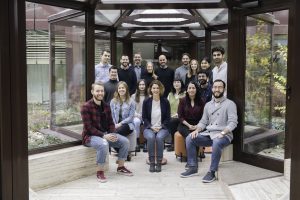
The interdisciplinary team at Innocise GmbH is working on a new generation of grippers for industry.
There is a lot going on technologically in Saarland, and the location is an excellent breeding ground for deep tech. There is of course a skills shortage here as well, but we find the people we need. We are also aided by the close networks enabling exchange with research institutes and courses of study, including for young companies. Furthermore, the educational structure of Saarland University, htw saar University of Applied Sciences and HBKsaar, focusing on the concept of interdisciplinary work, is perfect for us, including international courses of study.
We therefore had no issues recruiting a skilled, internationally-oriented team within a short period of time.
The gwSaar Saarland Economic Promotion Corporation also ensures ideal conditions for companies in Saarland. Its CEO Thomas Schuck summarises the comprehensive investor support available: ‘Saarland has an internationally renowned density of research. As the Saarland Economic Promotion Corporation, we ensure an ideal location for companies from the world of research. This is why areas such as the Science Park Saar were created. It is adjacent and a partner to Saarland’s research institutes. It is now home to more than 60 spin-offs and established companies as well as the Saarland NanoBio network and DV Saar, the German association for nanotechnology. We have positioned our economic promotion to enable us to provide optimum support to investors and companies based here, even with upscaling – from site information, to offices and laboratories, to production building spaces, we are able to capably support and advise on establishment and expansion projects throughout the entire relocation process.’
Author:
Anja Petschauer
Marketing Director
gwSaar Saarland Economic Promotion Corporation